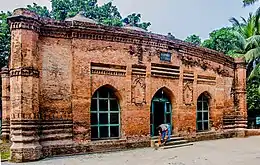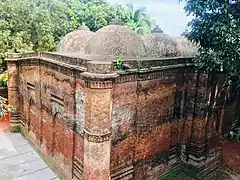Baba Adam's Mosque
Baba Adam's Mosque (Bengali: বাবা আদম মসজিদ, Arabic: مسجد بابا آدم) is a mosque situated in the village of Qadi Qasbah under Rampal Union of Bangladesh's Munshiganj District. It was constructed in 1483 A.D by Malik Kafur to function as a Jami mosque during the reign of Jalaluddin Fateh Shah.[1] The tomb of Baba Adam Shahid, a 15th-century Muslim preacher, lies near the edifice.
| Baba Adam's Mosque | |
|---|---|
বাবা আদম মসজিদ | |
 | |
| Religion | |
| Affiliation | Sunni Islam |
| Location | |
| Location | Munshiganj District, Bangladesh |
 Shown within Bangladesh | |
| Geographic coordinates | 23.556431°N 90.496350°E |
| Architecture | |
| Architect(s) | Malik al-Muazzam Malik Kafur |
| Type | Mosque |
| Style | Islamic architecture |
| Funded by | Jalaluddin Fateh Shah |
| Date established | 1483 AD |
| Specifications | |
| Length | 14.30m |
| Width | 11.45m |
| Interior area | 69.8625m² |
| Dome(s) | 6 |
| Website | |
| www | |
History


According to the Arabic calligraphy inscription fixed aloft the central doorway in the east, the mosque was built in Rajab 888 A.H (August/September 1483 AD) during the reign of the Sultan of Bengal Jalaluddin Fateh Shah. It was constructed by Malik al-Muʿazzam Malik Kafur, one of the Sultan's officers.[2][3] According to historian Ahmad Hasan Dani, Kafur was of Abyssinian origin.[4] Now a protected monument under the Department of Archaeology, the mosque has been renovated and remains in a good state of preservation.
Architecture
Split into two aisles and three bays, the rear of the wall on the west is displayed in three steps of which the middle part contains a multi-cusped ornamental arch-panel. The brick building is roofed over by six identical domes divided into two rows. Two freestanding slender octagonal-based black basalt pillars have chain and bell motifs. Stone pillars hold the pointed two-centred arches of the six domes.[5]
All the entrances and mihrabs are recessed within rectangular frames. The south and north walls contain rectangular niches. The multi-domed mosque does not have a minaret. On both sides of the central doorway there are two multi-cusped rectangular panels. The arches are supported on faceted small pillars and decorated with a beautiful terracotta floral design and a hanging motif. This type of facade decoration is also found in Shahzadpur Mosque (Sirajganj).[6]
Gallery
 Alternate view
Alternate view Design
Design.jpg.webp) Motif
Motif.jpg.webp) Corner
Corner.jpg.webp) Pillar
Pillar
See also
References
- Michell, George, The Islamic Heritage of Bengal, p. 128, ISBN 978-9231021749
- Sayeed, Dr. Abu, Mosque Architecture in Bangladesh, p. 98, ISBN 978-9843234698
- Ahmed, Dr. Nazimuddin, Discover the Monuments of Bangladesh, p. 158
- Ahmad Hasan Dani. "Analysis of the Inscriptions". Asiatic Society Of Pakistan Vol-ii. pp. 35 and 99.
- Begum, Ayesha (2012). "Bangladesh". In Islam, Sirajul; Miah, Sajahan; Khanam, Mahfuza; Ahmed, Sabbir (eds.). Banglapedia: the National Encyclopedia of Bangladesh (Online ed.). Dhaka, Bangladesh: Banglapedia Trust, Asiatic Society of Bangladesh. ISBN 984-32-0576-6. OCLC 52727562. Retrieved 7 February 2021.
- "Baba Adam's Mosque". munshigonj.com. Archived from the original on 2017-07-08. Retrieved 2018-10-05.
External links
| Wikimedia Commons has media related to Baba Adam's Mosque. |
_002.jpg.webp)